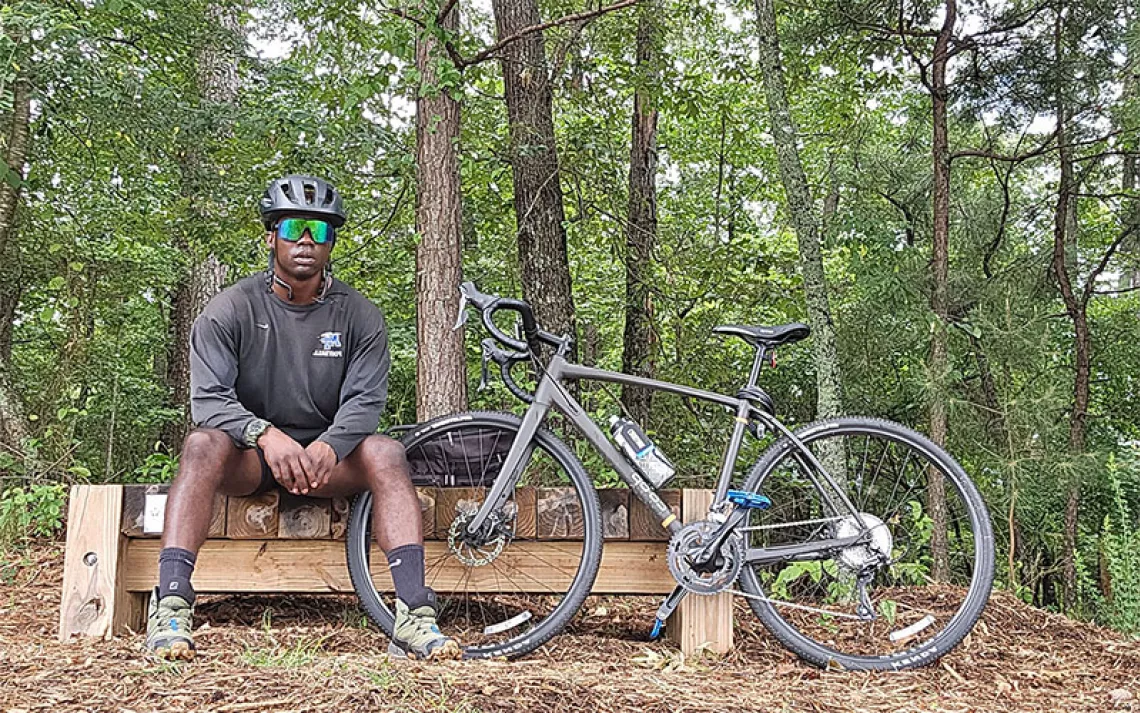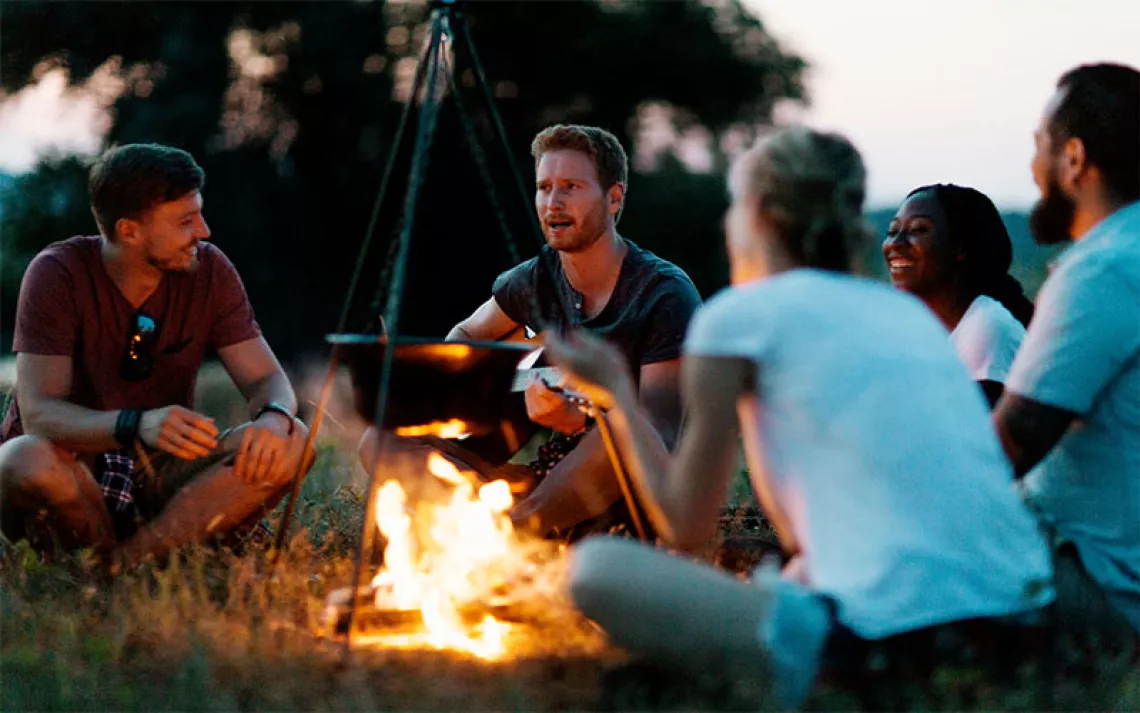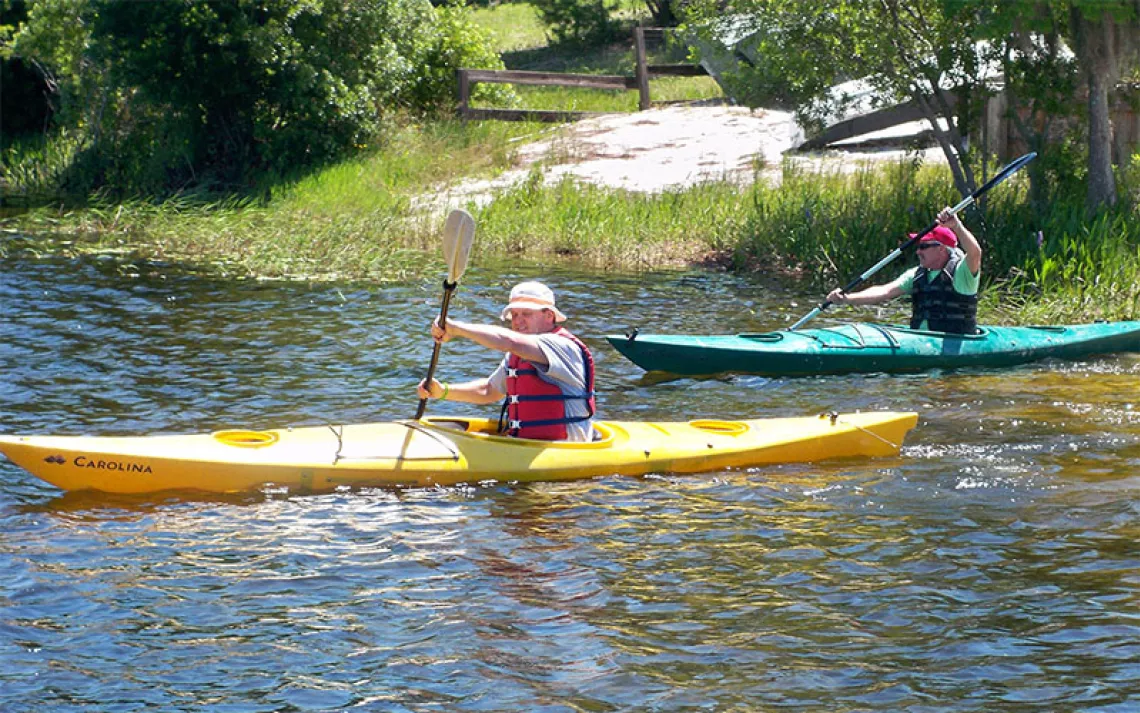Outdoors for All
A nascent global movement proclaims that access to nature is a human right

A FEW YEARS AGO, pediatrician and clinical scientist Nooshin Razani treated a four-year-old girl whose family had recently fled Yemen and settled in the San Francisco Bay Area. The family had received news the night before that members of the father's family had been killed in a bombing back home. The child was suffering from anxiety. "I was thinking, 'I have nothing to give to this little girl. What can I give her?'" Razani says. The typical medical response would be to offer the girl some counseling and, if necessary, medication. Razani decided the patient needed an additional, broader prescription. She asked the girl and her parents if they would like to go to the park with her. "The expression on that child's face, the yearning for a piece of childhood, was deeply moving," the doctor recalls.
Razani is the founder of the Center for Nature and Health, which conducts research on the connection between time in nature and health and is the nation's first nature-based clinic associated with a major health provider, UCSF Benioff Children's Hospital in Oakland, California. The clinic collaborates with the East Bay Regional Park District to offer a program called Stay Healthy in Nature Everyday. Participating physicians share local park maps with their patients and offer family nature outings–70 of them so far. Often, the physicians will join the outings. Burned-out doctors need these experiences too, Razani says.

"We did a randomized study of the impact on the participating families," she says. "Every single park visit substantially reduced parent stress." In June 2018, the center began billing insurance companies for patient visits that include nature connection as part of the treatment. This was a breakthrough for the increasing number of US health care professionals who now prescribe nature or integrate it into their practices in other ways, including pediatrician Robert Zarr in Washington, D.C., who organized Park Rx America to encourage health providers around the country to do the same. Neither Razani nor Zarr considers time in nature a panacea, but both regularly witness its preventive and therapeutic effects, particularly on children and adults undergoing traumatic stress.
The increased popularity of incorporating the healing power of nature into health care, public health programs, architecture, and education has been inspired by a relatively new body of scientific evidence that associates improved wellness and lower mortality rates with access to green and biodiverse spaces. In the span of a decade, the number of studies indicating that time spent in natural surroundings–whether groomed urban parks or unruly wilderness landscapes–can improve people's well-being has increased from dozens to hundreds. In 2017, a study published in the prestigious medical journal The Lancet Planetary Health suggested that people who live in green neighborhoods live longer than those with little nature nearby. The study tracked 1.3 million Canadian adults living in the country's 30 biggest cities and considered socioeconomic and education differences as control factors. Dan Crouse, a health geographer and the lead author of the study, told the Canadian Broadcasting Corporation, "There was a lot bigger effect than I think any of us had been expecting."
Expanding research has also shown that exposure to nature can reduce children's symptoms of attention deficit hyperactivity disorder and help prevent or reduce obesity, myopia, and vitamin D deficiency. And the research suggests that time spent in nature may improve social bonding and reduce violence, stimulate learning and creativity, help raise standardized test scores, and serve as a buffer to toxic stress, depression, and anxiety. Most of these findings are correlative, not causal. But longitudinal studies are beginning to support them.
The psychological, physical, and cognitive benefits of nature connection may be universal, but access to natural areas is not. Take the city of Oakland, where Razani practices. The neighborhoods with the most poverty are often those with the fewest parks and the least green space. "This is a social justice issue," she says. More than 90 percent of her clinic's patients are on Medi-Cal, living at or below the federal poverty line. Many suffer from a lack of nature access and from pollution in their immediate neighborhoods. According to a study published in Environmental Research, African American, Hispanic, and low-income children are most likely to be exposed to toxins at school. One reason is that school districts in less-affluent communities often place schools on cheaper land next to highways, factories, or contaminated sites. So teachers at such schools may be less likely to take their students outside to play or learn.
Every day, Razani witnesses the profound stress that urban families experience. She's seen families that lack the seemingly basic opportunity to spend time outside–parents who feel compelled to keep their children indoors because of neighborhood crime. "It's important not to assume that people with less income value nature less," Razani says. "This isn't a question of their values–it's about housing, about equal access to nature. . . . Some people get stuck on the idea that we need to teach people how to love nature. The truth is that people whose cultures were colonized often had more true nature connection in their histories than did the colonizers."

The concept of nature as a human right may sound radical, or like a dreamy fantasy. In a world in which millions of children are brutalized by war, hunger, and disease, can we spare time to advance a child's right to experience nature? For her part, Razani rejects the notion that equitable access to nature should be ranked lower in the hierarchy of human necessities. When her clinic takes in new patients, they're asked what they need most. Yes, housing, better food, and safety are on the list. But they also hunger for more nature in their lives.
Razani is not alone in making a rights-based claim on access to nature. A nascent global movement–made up of parents, educators, researchers, and health practitioners like Razani–insists that universal and equitable access to nature is fundamental to our humanity as well as to the future of life on Earth. Razani and others are making the case that nature connection should be recognized as a civil right–a human right.
This movement is grounded in biologist Edward O. Wilson's biophilia hypothesis–which suggests that human beings are genetically programmed to have an affiliation with the rest of nature–and anchored in ideals of justice and fairness. If Wilson is right, and if the research is correct, nature connection is more than a nice pursuit, a pastime, or a privilege. It is a necessity. In the words of David Orr, a leader in environmental education and green urban design, the human connection to a healthy natural environment is "the ultimate human right, upon which all other rights depend."

THE CONCEPT OF A HUMAN RIGHT to nature connection got its first major boost in September 2012, when Annelies Henstra, a Dutch human rights lawyer; Cheryl Charles, cofounder of the Children & Nature Network; and others made the case at the World Conservation Congress of the International Union for Conservation of Nature. Held in Jeju, South Korea, the conference attracted over 10,000 people, representing more than 200 governments and government organizations and more than 1,000 nongovernmental organizations. Through the leadership of Henstra, Charles, and Keith Wheeler, chair of the IUCN Commission on Education and Communication, the conference passed a historic resolution declaring that children have a human right to experience a healthy natural world. "That year, 2012, struck me as a pivotal year for the IUCN, in which a groundswell began to emerge within the organization to understand that if people don't connect to nature, beginning with children, that species, habitats, and ecosystems will be at increasing risk over time," Charles recalls. "This was a profound cultural shift . . . within the organization, as scientists and conservation leaders–who care passionately about wildlife and might just as soon keep people out of wild areas–were beginning to realize that people need to connect with nature personally in order to care about it."
The resolution, "Child's Right to Connect With Nature and to a Healthy Environment," begins by recognizing "the increasing disconnection of people and especially children from nature, and the adverse consequences for both healthy child development (nature deficit disorder) as well as responsible stewardship for nature and the environment in the future." The resolution goes on to state, "Growing up in a healthy environment and connecting children with nature is of such a fundamental importance for both children and the (future of) the conservation of nature and the protection of the environment, that it should be recognized and codified internationally as a human right for children."

Inspiring words, to be sure. But the IUCN delegates were determined that their grand rhetoric have real legal force behind it. The resolution called on the IUCN's membership to promote the inclusion of this right within the framework of the UN Convention on the Rights of the Child. That global treaty went into effect in 1990, and the countries that have ratified it are bound to its obligations through international law. (Every member nation of the UN has ratified it except the United States.) A Switzerland-based group, Terre des Hommes, which provides emergency relief and other health-related assistance to more than 3 million children and their families in more than 45 countries annually, is one of the organizations leading the effort to include access to nature in the existing UN agreement.
"The UN Convention on the Rights of the Child is one of the very few human rights instruments to refer to the environment," says Jonas Schubert, the organization's human rights officer. Schubert, a veteran of maneuvering through the UN's complicated processes, says that there may be a few ways to establish access to nature as a kind of guaranteed right. He points out that David Boyd, the UN special rapporteur on human rights and the environment, has already called on the UN Human Rights Council to recognize the right to a healthy environment. Another option would be to get the UN General Assembly to pass a resolution similar to the 2010 resolution recognizing every person's right to water–though Schubert says the current political climate, in which some already-established rights are under attack, "is not very conducive" to an expansion of rights.

In the meantime, Terre des Hommes is working to build support for the idea through global civil society, from the grassroots upward. This year, the organization will host workshops on children's rights and the environment in every major region of the world; the first one will take place in May 2019 in Colombia. "Our vision is to come up with a declaration on the right to a healthy environment by the end of the project," Schubert says. "We hope it will be a forceful statement that can inspire further action at different levels, including standards-setting." Another goal is to convince national, state, and provincial governments to pass resolutions–or, even better, establish policies–that ensure equitable access to the natural world as well as protection from environmental degradation.
Schubert says that he sees "no distinction" between advocating for biodiversity, healthy ecosystems, and personal nature connection. When it comes to the environment, his work focuses on two children's rights: One is the right to play. The other is what he calls "the right to development" for the children of today as well as for future generations. "A connection with nature is in my view an underlying determinant of the right to development and health," he says. "Without it, children would have difficulties to develop properly."
So far, the effort to establish access to nature as a human right has focused almost exclusively on children. This makes sense as both science and political strategy. Advocates rightly see a children-focused strategy as their best chance for starting a discussion about a rights-based approach to time in nature. Since children are most vulnerable to interruptions in their development, their welfare is of a higher concern.
Yet this strategy has one obvious omission: adults. Neurological research has revealed that the human brain has impressive "plasticity"–that is, the brain can grow new neural pathways throughout a person's life span. Typically these neural adaptations come during specific windows of opportunity, often sparked by peak experiences. When confronted by stunning scenery or a close encounter with a wild animal, we use more of our senses than we do when, say, staring at a computer screen. Filled with wonder, we continue the developmental process begun in childhood.
Every human is part of nature, sprung from the womb of the earth. Yet human civilization has sought to separate itself from nature and in the process has caused a psychological and physical alienation that affects every species. Nothing good comes of this widening wound. To place access to nature into a framework of human rights and responsibilities offers the promise of closing the cut. It brings into focus the interdependence of all species, the "inescapable network of mutuality" that Martin Luther King Jr. devoted his life to creating among humans.
If we can agree that access to the rest of nature is fundamental to our humanity, to our very being, it could open the way to a renewed ecological solidarity–an intertwining of human rights and the rights of all nature. In saving the earth, we save ourselves.
NATURE BECOMES MOST REAL when it moves from the head to the heart. "What is the extinction of the condor to a child who has never known a wren?" writes author and naturalist Robert Michael Pyle. It's a good line because it's true–and it's equally true for grown-ups.
Reversing biodiversity collapse and slowing climate change cannot be accomplished solely through politics, science, or technology. Success will require a far larger public constituency than exists today, one with a greater emotional and spiritual understanding of the interdependence of all species. While such understanding might be learned from a book, it can only be felt with one's feet on the ground.
To be clear, experiences in the natural world–whether in a wild forest or in an urban community garden–do not by themselves guarantee that people will care about protecting nature in the future. As children, the baby boom generation enjoyed significantly more access to the natural world than today's children and young people. The boomers did succeed in pushing environmental concerns onto the pages of newspapers and into the halls of Congress. At the same time, their unprecedented profligacy has pushed Earth systems to the brink of instability. Between 1970 and 2014, the global wildlife population shrank by 60 percent; global CO2 concentrations are above 400 parts per million and climbing. Regardless of how much time people have spent in nature, the destruction continues.

Closing the gap between human civilization and wild nature will require a set of values strong enough not only to protect endangered species and conserve energy but also to reshape health care, education, and whole cities, to conserve but also to generate new natural habitat–in effect, to regreen the earth.
The farmer-poet Wendell Berry writes of a war between two ethics: "The standard of the exploiter is efficiency; the standard of the nurturer is care. The exploiter's goal is money, profit; the nurturer's goal is health–his land's health, his own, his family's, his community's, his country's. . . . The exploiter typically serves an institution or organization; the nurturer serves land, household, community, place."
We don't have to look far to see these ethics in competition. During last winter's federal government shutdown, vandals trashed parts of Joshua Tree National Park in California. With park law enforcement reduced, some people toppled the fragile, threatened trees, raced four-wheelers across unspoiled desert (leaving tracks that could last hundreds of years), and flipped off people who objected. They were "accessing nature"–only to exploit it. Then came another response. Dozens of people volunteered to clean and repair the park as best they could. One of them was Rand Abbott, a paraplegic rock climber and advocate for Joshua tree conservation. He spent close to $5,000 on garbage bags and other supplies, then drove hundreds of miles to clean overflowing toilets and pick up garbage. His love for the desert and his bond with nature represented the ethic of care.
Where else can that ethic be learned if not in outdoor classrooms and natural schoolyards or on the trails of regional parks and in the deep wilderness? While doctors can offer such prescriptions, time in nature as a human right must be activated by democracy and available to all.
Recent developments across the world give reason for hope. Despite regulatory setbacks, pressure is building for a legislative response to climate change. Nature-based preschools, though still available mainly to more-affluent families, have increased in number by at least 500 percent since 2012. Urban agriculture is spreading fast, biophilic architecture is catching on, and wildlife corridors reach deeper into our cities. Families are planting their yards with native species that restore butterfly populations and migration routes.
The Scottish Wildland Trust reports that native woodlands cover a mere 4 percent of Scotland, and that, for children, the roaming distance from their home to play has shrunk considerably in 30 years. In 2005, a so-called right-to-roam law went into effect to address this issue and others. The Land Reform Act gives everyone a right to responsible access on most land and inland waterways throughout the country. Hikers can go just about anywhere on public and (most) private land if they treat the land and the owners of that land with respect. The law's advocates insist that rights and responsibilities are inseparable and that responsibilities must be taught and enforced. The right-to-roam law embodies the spirit of the words of poet Norman MacCaig that are etched on the side of the Scottish Parliament building: "Who possesses this landscape? The man who bought it or I who am possessed by it?"
Flowing in parallel to the demand for a human right to nature is another movement demanding that humans recognize the inalienable rights of nature. The effort to establish the rights of nonhuman nature has been slow, but it appears to be accelerating. In 2008, Ecuador changed its constitution to give nature "the right to exist, persist, maintain, and regenerate its vital cycles." In 2010, Bolivia passed the Law of the Rights of Mother Earth, giving nature rights equal to those of humans.
And in 2017, the New Zealand Parliament declared that the country's third-largest river, the Whanganui, has the same legal rights as a person. This made the Whanganui the first river in the world to be recognized as a living entity. The designation resulted from a 140-year campaign by New Zealand's Maori, who view the river as essential to the well-being of people and all the lives that depend on it for survival. The bill gave the river all the rights, duties, and liabilities that come with personhood; the river can now be represented in court proceedings. Two guardians will act on the river's behalf: a member of the Indigenous Whanganui Iwi community and a representative of the Crown.
Just as the Whanganui now possesses legal rights, all the plants and animals touched by the Whanganui–including people–have a right to enjoy that river. And if the river is not healthy? Then each and every one of those rights becomes meaningless.
The Catholic priest Thomas Berry, whom Newsweek called one of the world's most provocative eco-theologians, anticipated and aspired to this evolution of ethics. In his book The Great Work, he wrote, "The present urgency is to begin thinking within the context of the whole planet, the integral Earth community with all its human and other-than-human components. When we discuss ethics, we must understand it to mean the principles and values that govern that comprehensive community." Berry believed that "a degraded habitat will produce degraded humans." He also believed that "everything has a right to be recognized and revered. Trees have tree rights, insects have insect rights, rivers have river rights, and mountains have mountain rights."
Those lines were written 20 years ago, and the hour has grown later since. If the environmental movement is to flourish, it must ensure that people of all races, cultures, income levels, and zip codes have an equal chance to connect with the rest of the natural world. The concept of social capital can no longer apply to only one species; it should apply to all species. We can truly care for nature only if we see ourselves and nature as inseparable, only if we love ourselves as part of nature, only if we believe that we, our children, and our descendants have a right to the gifts of undestroyed nature.
Reconnecting the human species with the rest of the world is the great work of the 21st century, as Berry put it. Some of this work can be done by Congress or by the UN, by business and education and the great conservation organizations. The rest of it will be accomplished through small and meaningful acts, no more complicated than stepping outside among the trees with the people we love. That's what Dr. Razani encourages her patients to do.
"A lot of people are concerned that kids are spending too much time on computers," she says, "but what I see is parents and kids yearning for each other." She often begins a family session by asking the parents or grandparents what their childhood was like and about a special place in nature that they remember. "The room becomes very quiet. Sometimes the grandparents start to cry." And then she takes all of them to the park, together.
This article appeared in the May/June 2019 edition with the headline "Outdoors for All."
Tytia Habing is a self-taught photographer based in Watsonk, Illinois. Her work has appeared in many publications, including Lenscratch, Black + White magazine, The Sun, Shots magazine, and National Geographic.
This article was funded by the Sierra Club's Outdoors for All campaign (sierraclub.org/outdoors).
 The Magazine of The Sierra Club
The Magazine of The Sierra Club



